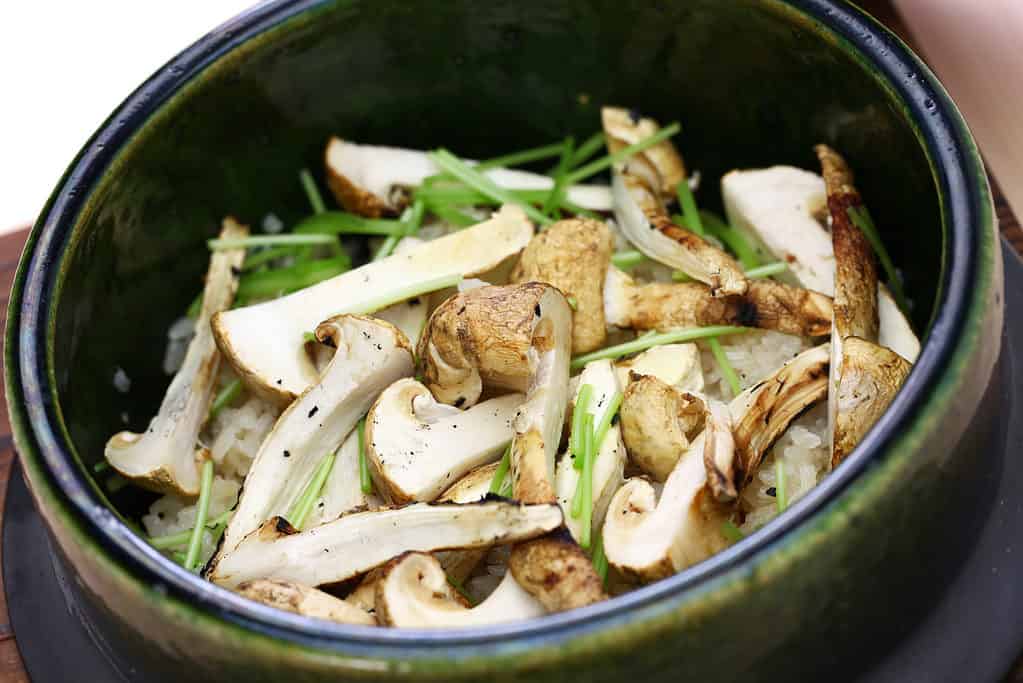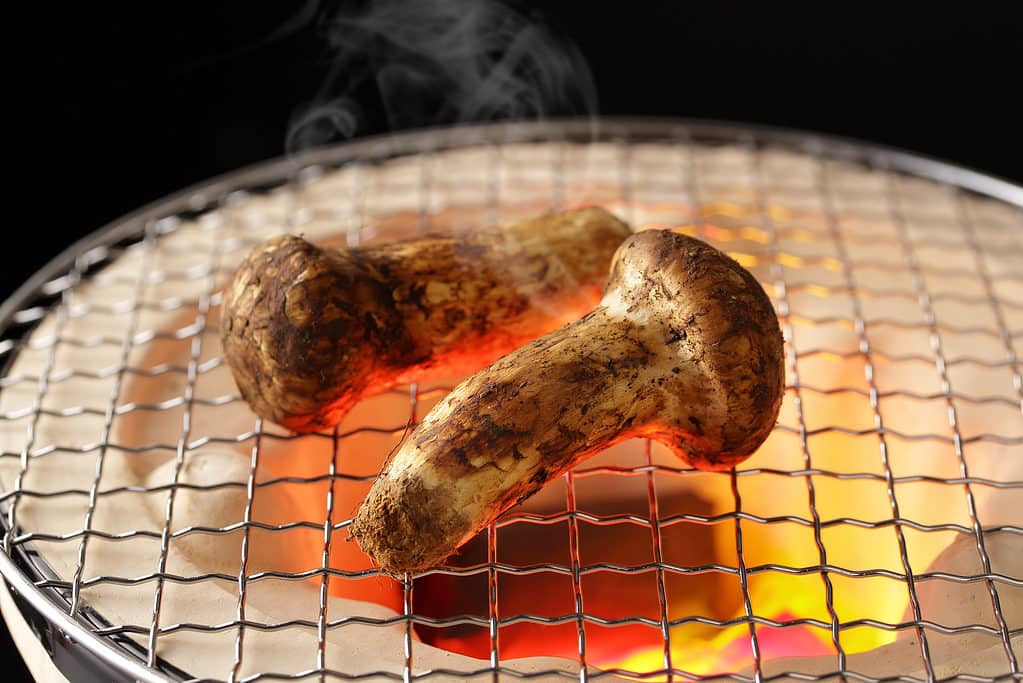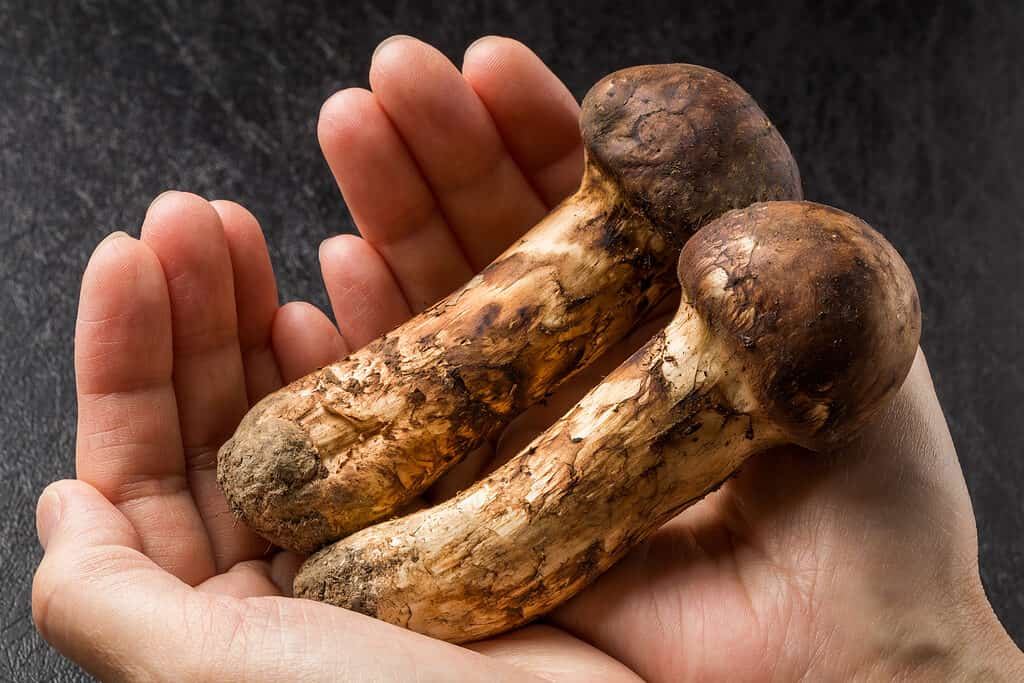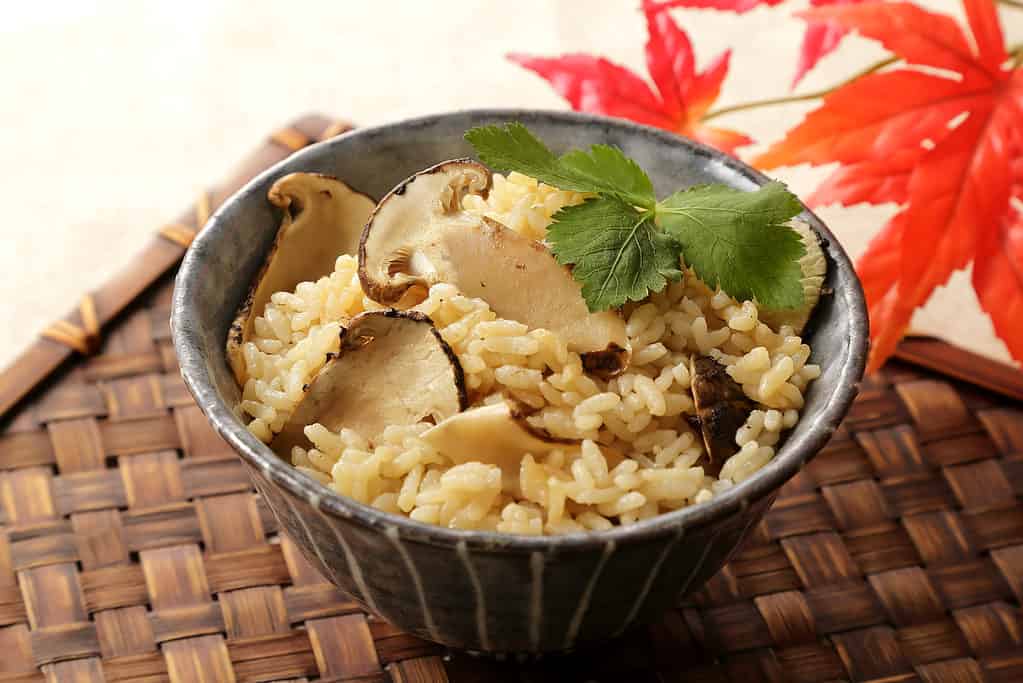A rare, delightful, and unusual mushroom, the matsutake is a prized edible wild mushroom that’s rarely cultivated and desired for its aromatic quality. The unique mushroom isn’t particularly distinctive looking – many mushrooms are “white or brown and chunky” but the aroma gives the mushroom away and makes it a big favorite among several Asian cultures.
The mushroom has some intriguing cousin species, as well, also called matsutake. Check out the differences and see if maybe you want to go exploring beneath the pine trees to find these unique mushrooms that will add a lot to that dinner table.
Classification

Fresh matsutake mushrooms may look “dirty.”
©ykokamoto/Shutterstock.com
The matsutake mushroom gets its name from the Japanese language, in which ‘matsu’ means pine tree and ‘take’ or ‘taki’ means mushroom. Many Japanes mushrooms are named this way – like the Shiitake mushroom (shii tree + mushroom). The scientific name for this delectable mushroom is Tricholoma matsutake. Another common name for the mushroom is the pine mushroom (not to be confused with red pine mushrooms).
This specific species does not occur in North America, save for commercial cultivation, primarily for Asian export, however there are three other species of matsutake mushrooms in the United States that may be found. These are the Tricholoma murrillianum, Tricholoma magnivelare, and Tricholoma mesoamericanum. The standard matsutake mushroom that’s in marketplaces is red-listed across most of the world, including China, Korea, Russian, Japan, Spain, Sweden, Norway, France, and Germany, largely because of deforestation and the decline of the species. This is largely why the mushroom is cultivated so much in the United States.
The mushrooms have a symbiotic relationship with the trees near which they live, meaning both the mushroom and the tree benefit from their presence.
Where Do Matsutake Mushrooms Grow?

They grow among the pine needles in forests.
©puttography/Shutterstock.com
Natively speaking, matsutake mushrooms grow in Asia, primarily Bhutan, Laos, parts of Europe in Estonia, Norway, Poland, Sweden, and Finland, with the other variations growing in the Pacific Northwest region of the United States and lower Canada. The mushroom is found elsewhere around the world in smaller numbers, such as in Colorado and Japan, but they are harder to come by in these locales for various reasons.
The mushrooms in North America prefer lodge pole pine forests and across the world, they prefer mixed conifer forests with pines. They’re typically available in autumn to early winter. They may grow among mountain forests as well as flatter woodlands, favoring lodge pole pines, ponderosa pines, douglas firs, pacific madrones, and shore pines.
Are Matsutake Mushrooms Safe to Eat?
Matsutake mushrooms are a prized culinary and medicinal mushroom in many cultures, particularly Asian and European contexts.
What Do Matsutake Mushrooms Taste Like?

They’re described as tasting like cinnamon, of all things.
©Stray Toki/Shutterstock.com
Matsutake mushrooms are both flavorful and aromatic, and interestingly enough, are actually favored more for their aroma than their flavor. They smell a bit of “autumn” with hints of cypress and sweet cinnamon, while their flavor reflects this in a spicy flavor described by some as “cinnamon and red hots” mixed with cedar and cypress tree. The description is odd, perhaps, but the mushroom offers a lot of intriguing opportunities because of this unique flavor and aroma profile.
Health Benefits

They’re often steamed with other vegetables and herbs.
©bonchan/Shutterstock.com
Like most mushroom species, matsutake mushrooms are full of healthy nutrients that are known to help improve the health through diet. They cannot replace medications and should never be used to do so, but they do add some health boosts naturally through consumption.
Some of the most acknowledge potential health benefits of matsutake mushrooms come from the fact that they are a good source of B vitamins, copper, protein, potassium, zinc, and selenium. They also contain dietary fiber that helps stimulate digestion and relieve constipation symptoms. It is believed that matsutake mushrooms also help
- Treat brain disease and Alzheimer’s
- Treat heart disease
- Prevent aging
- Prevent skin damage
- Reduce inflammation
- Help prevent tumors
- Fight off microbes and harmful bacteria
- Treat fatigue
- Boost general immunity
How Are Matsutake Mushrooms Used?

They may be prepared any number of ways.
©Nishihama/Shutterstock.com
Depending on the culture in which you’re cooking, matsutake mushrooms may be used for many recipes and meals. In Japan, for instance, the mushroom signifies autumn (much like pumpkin pie spice does in North America), so it is often grilled, roasted, and added to clear broths or paired with dashi to celebrate the season’s change. The mushrooms are also added to other soups and specific dishes like takikomi gohan, chawanmushi, and matsutake soup.
The mushrooms naturally release their flavor without frying or dairy, so many prefer grilling them or mixing them into clear, lighter meals that accentuate the distinctive flavor, including steamed rice and veggie dishes, and light broths. They’ve even been added to some sweet garnishes like matsutake fig jam.
How Much Do Matsutake Mushrooms Cost?
Matsutake mushrooms are not the most expensive mushrooms by far, but because they are more rare than say, button mushrooms, they bring a higher price than many species. They are typically between $40 and $70 per pound, with wholesale rights much lower, depending on the quality, purchase location, and size of the mushrooms.
They’re available in many specialty markets and online.
How to Identify Matsutake Mushrooms
Matsutake mushrooms may be identified through a variety of details. All of these details should be help in consideration together, however, to ensure you find the right mushroom and not some “knock off” or dangerous lookalike.
Matsutake Appearance

The appearance of matsutake is both unique and ordinary at once.
©ykokamoto/Shutterstock.com
The mushrooms are simple looking but distinctive. They have white caps, gills, and stems. At first blush, they could be mistaken for peppery milk caps, but if you look closer, you’ll see that that the caps start with an inrolled margin that may either be dry or sticky. The caps also flatten out to become funnel shaped as the mushroom matures. The caps are between 2 and 8 inches wide and have brown scales in the center.
Matsutake mushrooms have a white veil covering their gills when the mushroom is young, but as they grow, the veil breaks and leaves a ring at the top of the stem. The stems themselves are thick and dense and typically brownish when the mushroom is mature. They likely have white, fibrous scales like on the cap, and they may be shaggy. Note that the mushrooms often appear brown, however, because of these scales that may be more dominant on some specimens than others.
As you forage, it’s important to note that the mushroom stems are often completely unseen. The caps typically are all you’ll see of matsutake, with stems layered beneath the pine needles and often covered in clay and dirt. Sometimes, you can’t even see the cap, but rather a mushrump, or a mushroom-shaped bulge beneath the pine needle surface.
Matsutake Aroma – The Key to Identification
The key way to confirm you’ve found a matsutake mushroom is the aroma. It should have a strong, umami smell that’s a bit spicy and similar to sweet cinnamon.
Matsutake Season
First off, matsutake mushrooms are a seasonal fungus. They are distinctively autumn mushrooms that grow through early to mid-winter, depending on terrain, temperatures, and weather conditions. They begin their appearance when the summer heat shifts into autumn coolness.
Matsutake Habitat

They like to hide among the tree debris.
©dongrui/Shutterstock.com
Because they are pine mushrooms, they are predominantly found in conifer woods, specifically those where pine trees grow. They are often hidden among the needles and debris from pine trees and their neighbors and often go overlooked because of this.
They grow on the forest floor, not on trees or stumps. They have living symbiotic partners, not dead trees. They typically are mingled in between tree roots.
Growth Patterns
Matsutake mushrooms grow in groups, in line, in arches, or semi-circles. They almost never grow as solo shrooms and even when they do, they’re still fairly close to others without overlapping each other.
How to Forage for Matsutake Mushrooms

They’re fairly large mushrooms.
©norikko/Shutterstock.com
Matsutake mushrooms are a fun, albeit involved, mushroom to forage for. They don’t pop their little caps up above the surface where they show off their color and clarity like many species do. Instead, they stay hidden, bulging up beneath the blanket of forest debris like pine needles and leaves. So, as you go out foraging for these little mushrooms, you’re going to need to keep an eye peeled, or you’ll miss them altogether.
Be in the Right Place
First and foremost, matsutake mushrooms are going to be located in pine or conifer filled wooded areas. They are called pine mushrooms for a reason.
Walk Carefully Through the Woods
Since you’re looking for hidden mushrooms, its best to avoid trampling and instead, take a slow, calculated walk as you make your way through the trees. You’ll disturb the ground less and damage fewer mushrooms this way.
Look Closely as You Walk
As you make your way through the forests, particularly among pines and other conifers, look for tell-tale signs of pine mushrooms: small bulges beneath the needle duff. The mushrooms are likely just beneath, with their caps the only thing visible once you peal back the layer.
Avoid Raking the Ground
While the first instinct might be to rake the ground to find matsutakes, this will actually cause long-term damage to the growth of the mushrooms and the habitat of the creatures living nearby. Instead, wear some gloves and remove the debris to reveal the mushrooms.
Cut the Mushrooms
There’s some debate among folks on whether to pluck or cut matsutakes, but the general best practice for wild mushrooms is to cut them rather than pull them up by the roots. The reason being that if you pluck them up, they won’t leave behind roots to grow from again next year.
So, using a knife or shears, cut the mushrooms.
And never cut the entire patch. Be sure to leave some of the mushrooms from each patch behind for more growth later on and for the wildlife that eats the mushrooms.
Matsutake Mushroom Trivia

They’re often used in rice dishes.
©Nishihama/Shutterstock.com
Pine mushrooms are rare, wild, and edibly delicious fungi distinctively thought of as Japanese in most situations. Part of why these mushrooms cannot be commercially cultivated is because of the symbiotic relationship of the mushroom with their partner trees. To create this kind of setting for cultivation would be extremely difficult, so most don’t both. The mushrooms have waned in Japan, due to disease, so they are highly prized in Japan, China, and Korea, and typically fetch a high price and are in high demand as an export from North America where they are in less demand.
Intriguingly, the mushrooms were only ever eaten by the imperial court until the 17th Century. They remain a status symbol now and are often given as gifts of blessing to newly weds as a symbol of good fortune, happiness, and fertility. They’re often placed in opulently decorated wooden boxes with equally decorative sake glasses.
Up Next:
- Death Cap Mushrooms: A Complete Guide
- Discover the Largest Mushroom Ever Grown
- Are Mushrooms and Other Fungus Plants?
Mushroom Hunting in Pennsylvania: A Complete Guide
The photo featured at the top of this post is © puttography/Shutterstock.com
The information presented on or through the Website is made available solely for general informational purposes. We do not warrant the accuracy, completeness, or usefulness of this information. Any reliance you place on such information is strictly at your own risk. We disclaim all liability and responsibility arising from any reliance placed on such materials by you or any other visitor to the Website, or by anyone who may be informed of any of its contents. None of the statements or claims on the Website should be taken as medical advice, health advice, or as confirmation that a plant, fungus, or other item is safe for consumption or will provide any health benefits. Anyone considering the health benefits of particular plant, fungus, or other item should first consult with a doctor or other medical professional. The statements made within this Website have not been evaluated by the Food and Drug Administration. These statements are not intended to diagnose, treat, cure or prevent any disease.
Sources
- Mushroom Appreciation, Available here: https://www.mushroom-appreciation.com/american-matsutake.html
- Modern Forager, Available here: https://www.modern-forager.com/the-marvelous-and-mysterious-matsutake/
- Just One Cookbook, Available here: https://www.justonecookbook.com/matsutake-mushroom/
- Food Thesis, Available here: https://foodthesis.com/tricholoma-matsutake-mushroom-health-benefits/
- Specialty Produce, Available here: https://specialtyproduce.com/produce/Matsutake_Mushrooms_724.php
- Wikipedia, Available here: https://en.wikipedia.org/wiki/Matsutake
Thank you for reading! Have some feedback for us? Contact the AZ Animals editorial team.






